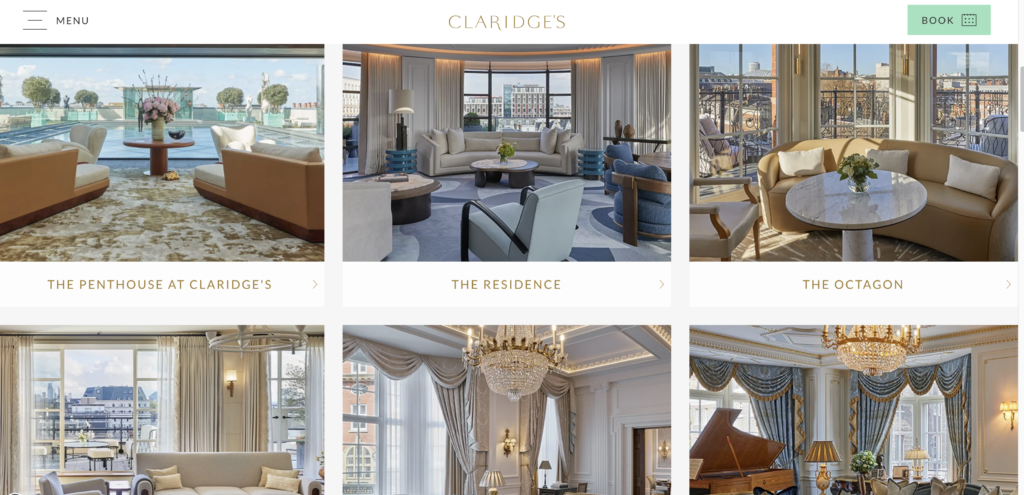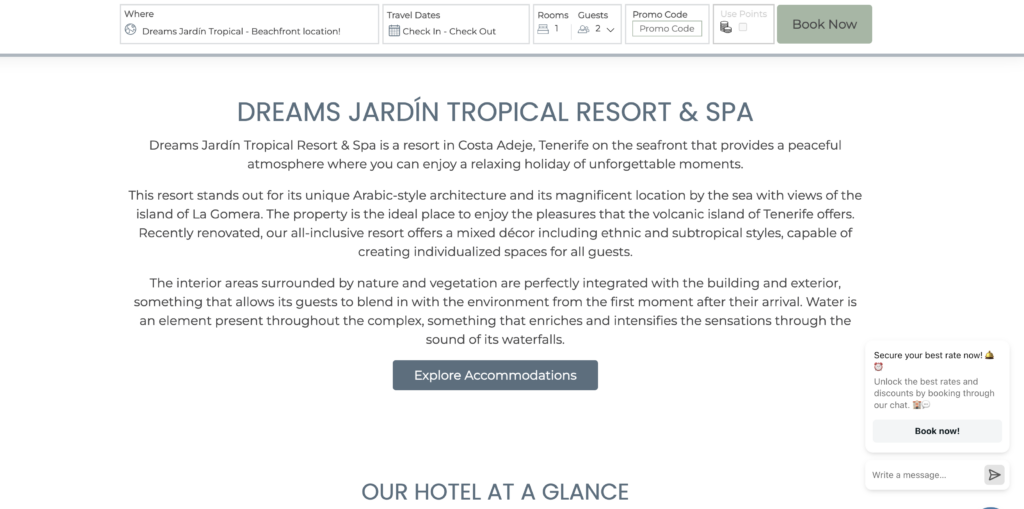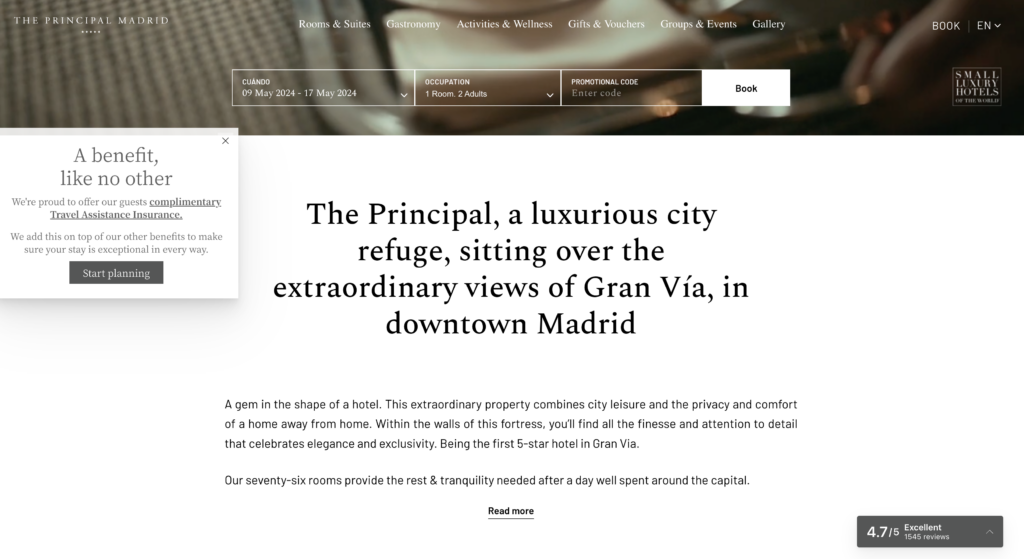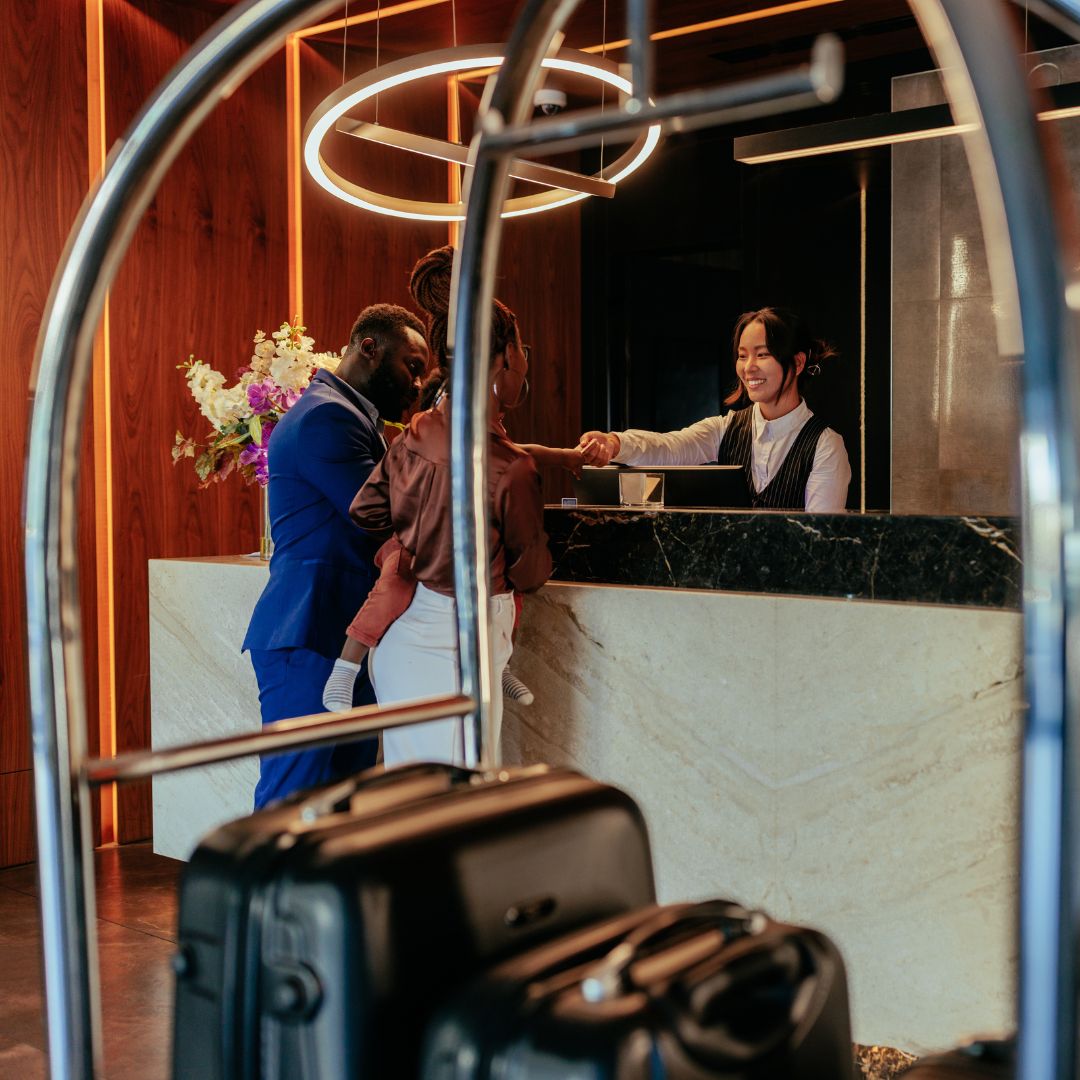Your hotel’s online presence is your digital lobby—a welcoming space that entices guests to step inside and explore further. Just as a dirty room or a rude receptionist can deter guests from staying at your hotel, web design mistakes can have a similarly negative impact on your hotel’s profitability and reputation.
Guests no longer tolerate subpar online experiences; a poorly designed website can erode trust and drive them into the arms of your competitors. Neglecting your site’s design isn’t just a faux pas; it’s a self-inflicted wound that undermines your business’s potential for success.
In this blog, we’ll explore the six web design mistakes you might be making in your hotel business—and, crucially, how to avoid them. From confusing navigation to outdated aesthetics, each mistake can potentially drive guests away and tarnish your brand image.
Let’s get into it! How can you avoid the following web design mistakes and elevate your online presence so that it leaves a lasting impression for all the right reasons?
Identifying and Avoiding the Top 6 Web Design Mistakes
- Overlooking mobile optimisation in the hotel industry
- A complex booking process can discourage potential bookings
- Do not neglect SEO practices; SEO increases visibility and potential conversions
Web Design Mistake 1: Ignoring Mobile Optimisation
This is an obvious one – everyone is on their phones! Hotels ignoring mobile optimisation are putting themselves at a significant disadvantage. In fact, as of 2023, ‘Mobile devices (excluding tablets) generated 58.67 percent of global website traffic.’ This figure has increased since the pandemic – So why wouldn’t you make sure your hotel’s website is optimised for a seamless mobile experience?
Ignoring mobile optimisation is a mistake that could directly impact your hotel’s bookings and conversions. It not only affects user experience but could also tarnish your brand reputation. With a mobile-friendly design, your potential customers are a mere few taps away from their next relaxing holiday or business trip.
Web Design Mistake 2: Lack of High-Quality Visuals
Imagery speaks volumes. As the saying goes, “A picture is worth a thousand words”, and in the hotel business, mediocre visuals on your website can cost you.
According to Hubspot, ‘50% of marketers leverage video in their marketing strategy, followed closely by images at 47%.’ Visitors create mental pictures from the images and videos they see on your site – using low-quality images can tarnish your brand’s perceived value.
A grainy, low-resolution image can make even the most luxurious hotels look drab and uninviting. The negative perception formed may discourage potential guests from booking, adversely impacting your business.
Investing in high-quality images and videos accurately representing your brand can improve your website’s attractiveness and increase booking rates. So, ensure your visuals are top-notch and accurately represent your brand and services.
For example, Claridge’s is a well-known Mayfair hotel renowned for its timeless elegance and impeccable service. Its website showcases exquisite images of the hotel’s iconic Art Deco interiors, luxurious guest rooms, and Michelin-starred dining venues. The high-quality photography captures the essence of Claridge’s sophisticated charm, inspiring visitors to experience the epitome of London luxury.

Web Design Mistake 3: Neglecting SEO Practices
Ignoring SEO practices can be detrimental to your hotel business. When done correctly, SEO ensures that your site appears when potential customers are seeking accommodation, increasing your chances of a booking.
Most people do not scroll down search engine results very far, so ensuring your hotel website is SEO-optimised is essential. A report by First Page Sage found that ‘The top 3 organic search results receive more than two-thirds (68.7%) of all clicks on the Google Search page.’
You can’t just appear on the first page of Google overnight, though. SEO requires consistently producing high-quality content, optimising site speed, structuring URLs, and many other on-page and off-page practices.
SEO for your hotel goes beyond traditional SEO methods, but that’s another blog post!
Web Design Mistake 4: Overcomplicating the Booking Process
An overly complicated booking process can be a significant deterrent for your potential customers. According to research conducted by Baymard, some of the reasons why customers abandon their carts are:
- 22% said it was a ‘Too long/complicated checkout process’
- 17% said the ‘Website had errors/crashed’
- 25% said, ‘I didn’t trust the site with my credit card information.’
A good-quality and straightforward website design can avoid all of these reasons that would prevent someone from making a booking. A streamlined, user-friendly booking process is essential. Simplify the process, ask for vital information only, and offer a variety of secure payment options. A user-friendly booking process ensures your potential customers experience less friction in their booking journey, increasing the probability of conversion.
Web Design Mistake 5: Lack of Clear Call-to-Action (CTA)
A clear call-to-action (CTA) is crucial for driving your website’s visitors to take the desired action. Whether booking a room, requesting a service, or subscribing to your newsletter, a well-crafted CTA guides users on what to do next, eliminating unnecessary guesswork.
A well-designed hotel website will be clear about what it wants its visitors to do and guide them in taking the desired action with a clear and compelling CTA.
Good examples of clear CTAs for hotels


The Impact of a Strong CTA
Here, you can see CTAs in action! Hyatt shows clear CTAs on its landing pages, making it easy for visitors to navigate and encouraging them to stay on the website and explore further.

A compelling CTA can be the difference between a website visitor and a booked room. It nudges visitors to take the next step, providing a smooth and streamlined booking experience. So, never underestimate the power of a well-placed and compelling CTA.
Web Design Mistake 6: Failing to Highlight Unique Selling Points (USPs)
Your Unique Selling Points (USPs) set you apart from your competitors. Many hotel businesses are guilty of hiding their USPs in a corner of their website, making them hard to find for potential customers. Emphasising your USPs makes you stand out and gives your customers compelling reasons to choose you over competitors.
Ensure you show your USPs prominently on your homepage. This will keep visitors from guessing or hunting them down. It’s not their job to find a reason to visit your hotel; it’s your job as a business owner or marketer to show them.
Clear and well-placed USPs can be that subtle pull that makes potential customers reach for their wallets and book a room.
Understanding the Impact of Web Design Mistakes on Your Hotel Business
- Web design mistakes can directly and indirectly influence revenue and brand perception.
- Improper web design can discourage potential clients from booking.
- Your brand’s image can suffer due to poor web presence.
The Direct Impact on Revenue
Ignoring the contemporary trends and critical aspects of web designing can bring a direct hit to your overall profit. Let’s break it down:
Loss of Potential Clients
One of the most significant hits you can take from a poorly designed website is the loss of potential customers. Imagine this: a visitor lands on your website, but because of slow loading speed, cluttered design, or hard-to-navigate pages, they exit before even exploring your services. This scenario directly impacts your hotel’s revenue, as every visitor who bounces off represents a lost potential client and, consequently, lost income.
According to Hubspot, ‘A good bounce rate is around 40% or lower. And a bounce rate of 60% or higher may be an indication you need to evaluate your page content.’ Visitors bouncing off your site without making any bookings or even exploring can indicate that:
- They didn’t find what they were looking for
- Your website could have been more appealing
- Your website could have been more user-friendly
This behaviour inevitably results in declining reservations, influencing your business revenue. Therefore, investing in a well-designed website with an optimised user experience is crucial for maximising revenue potential and minimising bounce rates.
The Indirect Impact on Brand Image and Customer Perception
The design of your website is critical in dictating your brand’s digital image. Let’s delve into some ways it can impact:
Influence on Brand’s Image
The look and feel of your website reflect your brand’s personality. If your website appears outdated or poorly designed, visitors might presume the same about your hotel services. A substandard website may inadvertently portray your brand as unprofessional and uncaring about user experience, damaging your business’s reputation.
Altering Customer Perception
Poorly designed websites can significantly lower the chance of potential customers trusting your hotel. According to Stanford Web Credibility Research, ‘75% of users admit to making judgments about a company’s credibility based on their website’s design.’ Misrepresented images, outdated design, missing information, grammatical errors or even broken links can cause visitors to question your attention to detail and might deter them from choosing your services.
Understanding the Basics of Web Design for Hotel Businesses
- Web design’s role in hotel businesses
- Key components of a successful hotel website
What is Web Design, and Why is it Important for Hotel Businesses?
Web design is a blend of graphic design and computer programming. It’s an integral part of any business, and it has a profound impact on hotel businesses.
A hotel’s website is typically the first interaction potential customers have with the brand. It frames initial perceptions, influencing whether the viewer will convert into a guest or move on to a competitor. An attractive, well-structured, user-friendly web design can directly contribute to customer retention and acquisition.
A practical design with easy navigation can convey a sense of trust and sophistication, elevating the perceived value of your service.
Key Elements of a Successful Hotel Website
Responsive Design
One of the significant components of modern web design is responsive design. This approach effortlessly adapts a website’s layout to the size of the viewer’s screen. It’s vital since an increasing number of travellers use their smartphones to book hotels. Your website should look and function optimally on many devices.
High-Quality Visual Content
Travel and hospitality are visual industries. Therefore, gripping visuals can be a compelling hook for potential guests. Feature high-resolution, professionally shot images of your rooms, amenity spaces, and local attractions to paint a vibrant picture of what guests can anticipate.
Speed and Simplicity
No one has patience anymore. We live in a speedy, high-demand world. Users expect instant gratification and have little patience for slow-loading sites. Your web pages should load within two to three seconds to prevent users from bouncing to your competition. Also, maintaining simplicity in design and easy navigation provides a positive user experience.
Relevant and Updated Content
Keep your content updated regularly, ensuring all information about the hotel, its services, and local attractions is accurate. Valuable and contemporary content can attract more views and give a sense of reliability among potential guests.
Direct Booking Functionality
A booking engine integrated into your website streamlines the booking process and makes it convenient for potential guests. It removes unnecessary intermediaries and further bolsters direct reservations.

Remember, comprehensive but straightforward is the key to designing a successful hotel website. Creating a balance between aesthetics and functionality will offer a rewarding browsing experience to your users, potentially increasing bookings and boosting your overall business.
Conclusion
There you have it: six web design mistakes to avoid.
Consistent branding, mobile optimisation, and fast loading speeds exude professionalism. Targeted SEO and a seamless booking process drive conversions. Avoiding clutter and unnecessary content helps visitors navigate your site easily.
Remember, every design element of your hotel’s website contributes to your guests’ online experience and, ultimately, their decision to book a room. Ensuring your website is user-friendly and optimised effectively is crucial to your business’s success.
Now, review your current website design. What changes can you make today that could improve your guests’ experience and increase your chances of bookings? Think about your favourite online experiences—how can you create a similar feeling for your hotel’s visitors?
A website is only ever partially complete. It continuously evolves and adapts according to the times.
For more marketing tips, follow us on our social platforms or listen to our marketing podcast, Horizon by Hummingbird. We discuss everything from SEO to advertising to social media and more!



